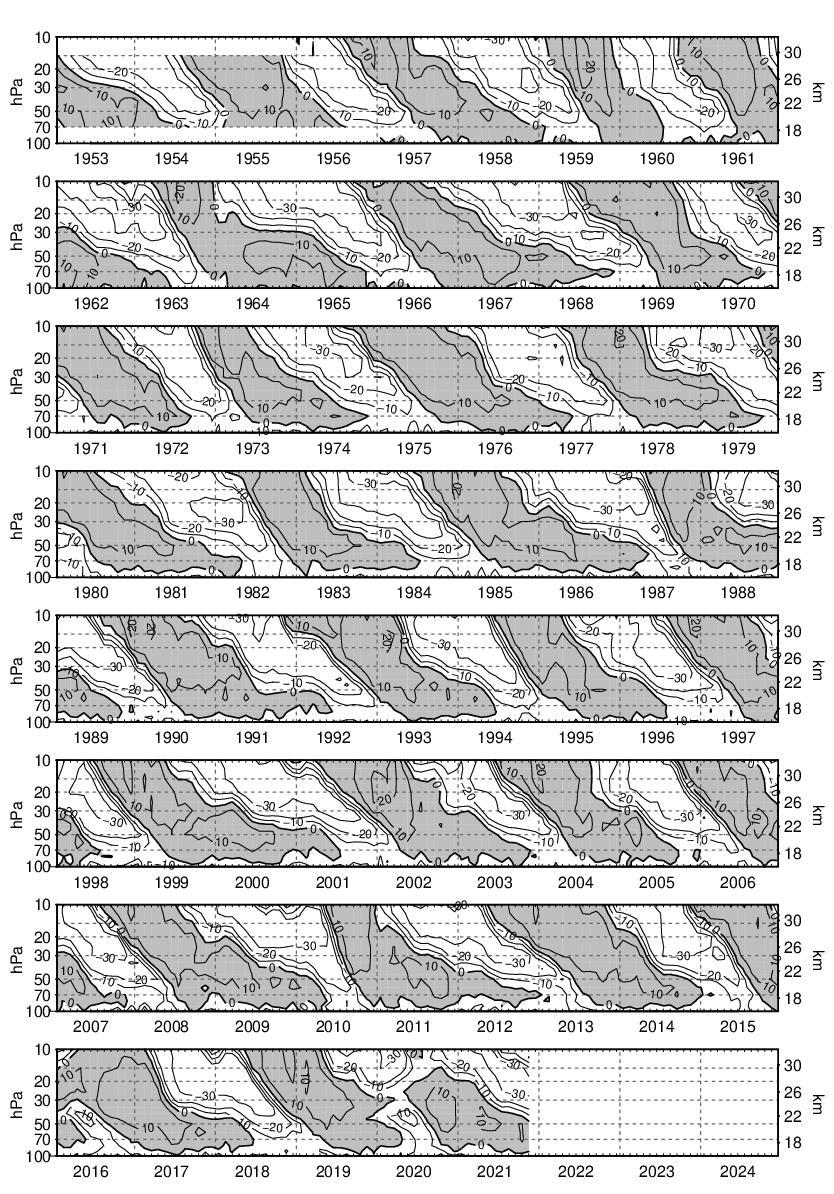The Quasi-Biennial-Oscillation (QBO) Data Serie
BACK AGAIN: FU BERLIN QBO-TIMESERIES NOW AT KIT
The former FU Berlin Atmospheric Dynamics (and Stratosphere) research group is happy to announce that the Berlin QBO-timeseries will be continued by the Institute of Meteorology and Climate Research at the Karlsruhe Institute of Technology (KIT). At KIT, the QBO will be calculated based on the original method of analysis developed at FU Berlin. The FU Berlin QBO timeseries will thus be continued in a consistent manner into the future.
Further information and the completed, up-to-date QBO-timeseries are found at: https://www.atmohub.kit.edu/english/807.php
QBO
Data Compilation | Data access | Structure of the QBO | References | Contact
Data Compilation
Almost 50 years ago, the Quasi-Biennial Oscillation (QBO) of the winds in the equatorial stratosphere was detected due to the establishment of a global, regularly measuring radiosonde network (Graystone, 1959; Ebdon, 1960).
As part of the compilation of our daily stratospheric charts we have tabulated the daily wind observations of selected stations near the equator since 1957. For the earlier years, the values were extracted from the Northern Hemisphere Data Tabulations. From these daily values the monthly mean zonal wind components were calculated for the levels 70, 50, 40, 30, 20, 15, and 10 hPa and a data set from 1953 to the present was produced by combining the observations of the three radiosonde stations Canton Island (closed 1967), Gan/Maledive Islands (closed 1975), and Singapore (data file: qbo.dat).
This data set is supposed to be representative of the equatorial belt since all studies have shown that longitudinal differences in the phase of the QBO are small. It should be noted, however, that some uncertainties arose at higher levels during the early years from the scarcity of observations. More information on the original data can be found in Naujokat (1986).
A second data set has been produced since 1987 from the Singapore data by using the daily vertical wind profiles to obtain a higher vertical resolution. In this set you will find the monthly mean zonal wind components at Singapore for every year from 1987 to the present at the levels 100 (since 1997), 90, 80, 70, 60, 50, 45, 40, 35, 30, 25, 20, 15, 12, and 10-hPa (singapore.dat).
Data access
The data files are in ASCII format and can be downloaded bellow. The archive files (*.zip and *.tgz) contain the files: qbo.dat, singapore.dat, singapore2020.dat, and singapore2021.dat.
- qbo.dat (starting 1953)
- singapore.dat (starting 1987)
- singapore2020.dat
- singapore2021.dat
- qbo_data_zip.zip
- qbo_data_tgz.tgz
The QBO time series is updated until November 2021.
Note: Depending on your browser configuration it might happen that the data files, due to the file suffix .dat, will be related to the quicktime application. In this case please use the possibility to save the data files on your hard disk (right click, save link as ...) before open them with a text editor.
Structure of the QBO
The time-height section derived from these data in Fig.30 shows the observed structure of the QBO at equatorial latitudes:
- alternating easterly and westerly wind regimes propagate downward with time;
- westerlies move down faster and more regularly than easterlies;
- the transition to easterlies is often delayed between 30 and 50 hPa;
- easterlies are generally stronger (30-35 m/s) than westerlies (15-20 m/s);
- maximum amplitudes of both phases typically occur near 20-hPa;
- the average period is about 27 months;
- both period and amplitude considerably vary from cycle to cycle.

Figure 1: Time-height section of monthly mean zonal winds (m/s) at equatorial stations: Canton Island, 3°S/172°W (Jan 1953 - Aug 1967), Gan/Maledive Islands, 1°S/73°E (Sep 1967 - Dec 1975) and Singapore, 1°N/104°E (since Jan 1976). Isopleths are at 10 m/s intervals; westerlies are shaded (updated from Naujokat, 1986) (download pdf).
Detailed information on all aspects of the QBO, its dynamics and its global effects, can be found in a most recent review paper of Baldwin et al (2001), including a comprehensive bibliography. A study of the coupling between the tropical QBO and the global stratospheric circulation has been performed by Marquardt (1998).
References
Baldwin, M.P., L.J. Gray, T.J. Dunkerton, K. Hamilton, P.H. Haynes, W.J. Randel, J.R. Holton, M.J. Alexander, I. Hirota, T. Horinouchi, D.B.A. Jones, J.S. Kinnersley, C. Marquardt, K. Sato, and M. Takahashi, 2001: The Quasi-Biennial Oscillation. Reviews of Geophys., 39, 179-229.
Ebdon, R. A. , 1960: Notes on the wind flow at 50 mb in tropical and sub-tropical regions in January 1957 and January 1958. Q. J. Roy. Met. Soc., 86, 540-542.
Graystone, P., 1959: Meteorological office discussion on tropical meteorology. Met. Magazine, 88, 117.
Naujokat, B., 1986: An update of the observed quasi-biennial oscillation of the stratospheric winds over the tropics. J. Atmos. Sci., 43, 1873-1877.
Marquardt, C. and B. Naujokat, 1997: An update of the equatorial QBO and its variability. SPARC Melbourne, WMO/TD-NO. 814, 87-90.
Marquardt, C., 1998: Die tropische QBO und dynamische Prozesse in der Stratosphäre. PhD Thesis, Met. Abh. FU-Berlin, Serie A, Band 9/Heft 4, Verlag Dietrich Reimer Berlin, 260 S.
Contact
For questions concerning the QBO data series please contact: Markus Kunze (markus.kunze@met.fu-berlin.de).

